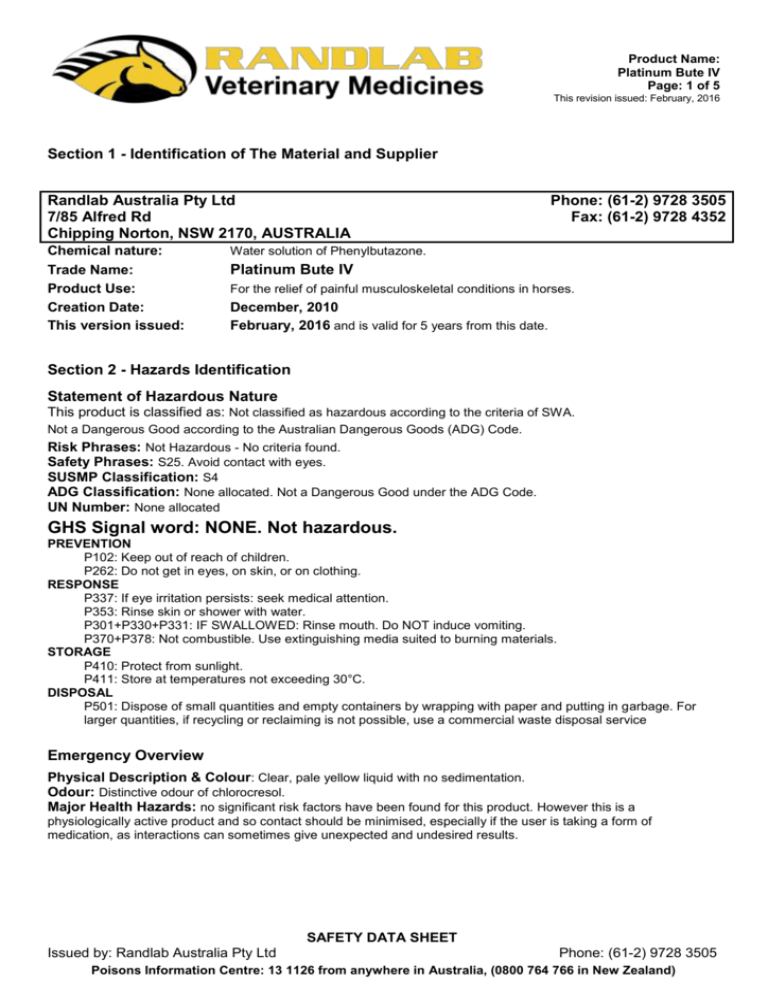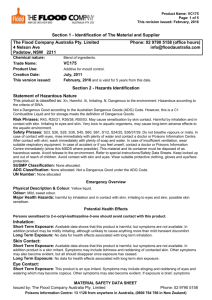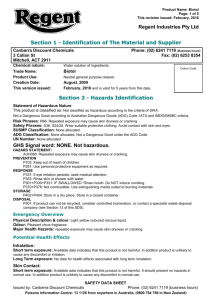Platinum Bute IV
advertisement

Product Name: Platinum Bute IV Page: 1 of 5 This revision issued: February, 2016 Section 1 - Identification of The Material and Supplier Randlab Australia Pty Ltd 7/85 Alfred Rd Chipping Norton, NSW 2170, AUSTRALIA Chemical nature: Water solution of Phenylbutazone. Trade Name: Product Use: Creation Date: This version issued: Platinum Bute IV Phone: (61-2) 9728 3505 Fax: (61-2) 9728 4352 For the relief of painful musculoskeletal conditions in horses. December, 2010 February, 2016 and is valid for 5 years from this date. Section 2 - Hazards Identification Statement of Hazardous Nature This product is classified as: Not classified as hazardous according to the criteria of SWA. Not a Dangerous Good according to the Australian Dangerous Goods (ADG) Code. Risk Phrases: Not Hazardous - No criteria found. Safety Phrases: S25. Avoid contact with eyes. SUSMP Classification: S4 ADG Classification: None allocated. Not a Dangerous Good under the ADG Code. UN Number: None allocated GHS Signal word: NONE. Not hazardous. PREVENTION P102: Keep out of reach of children. P262: Do not get in eyes, on skin, or on clothing. RESPONSE P337: If eye irritation persists: seek medical attention. P353: Rinse skin or shower with water. P301+P330+P331: IF SWALLOWED: Rinse mouth. Do NOT induce vomiting. P370+P378: Not combustible. Use extinguishing media suited to burning materials. STORAGE P410: Protect from sunlight. P411: Store at temperatures not exceeding 30°C. DISPOSAL P501: Dispose of small quantities and empty containers by wrapping with paper and putting in garbage. For larger quantities, if recycling or reclaiming is not possible, use a commercial waste disposal service Emergency Overview Physical Description & Colour: Clear, pale yellow liquid with no sedimentation. Odour: Distinctive odour of chlorocresol. Major Health Hazards: no significant risk factors have been found for this product. However this is a physiologically active product and so contact should be minimised, especially if the user is taking a form of medication, as interactions can sometimes give unexpected and undesired results. SAFETY DATA SHEET Issued by: Randlab Australia Pty Ltd Phone: (61-2) 9728 3505 Poisons Information Centre: 13 1126 from anywhere in Australia, (0800 764 766 in New Zealand) Product Name: Platinum Bute IV Page: 2 of 5 This revision issued: February, 2016 Potential Health Effects Inhalation: Short Term Exposure: Available data indicates that this product is not harmful. In addition product is unlikely to cause any discomfort or irritation. Long Term Exposure: No data for health effects associated with long term inhalation. Skin Contact: Short Term Exposure: Available data indicates that this product is not harmful. It should present no hazards in normal use. In addition product is unlikely to cause any discomfort in normal use. Long Term Exposure: No data for health effects associated with long term skin exposure. Eye Contact: Short Term Exposure: This product may be irritating to eyes, but is unlikely to cause anything more than mild transient discomfort. Long Term Exposure: No data for health effects associated with long term eye exposure. Ingestion: Short Term Exposure: Significant oral exposure is considered to be unlikely. However, this product may be irritating to mucous membranes but is unlikely to cause anything more than transient discomfort. Long Term Exposure: No data for health effects associated with long term ingestion. Carcinogen Status: SWA: No significant ingredient is classified as carcinogenic by SWA. NTP: No significant ingredient is classified as carcinogenic by NTP. IARC: Phenylbutazone is Class 3 - unclassifiable as to carcinogenicity to humans. See the IARC website for further details. A web address has not been provided as addresses frequently change. Section 3 - Composition/Information on Ingredients Ingredients CAS No Conc,% TWA (mg/m3) STEL (mg/m3) Phenylbutazone as sodium salt 50-33-9 200mg/mL not set not set Sodium salicylate 54-21-7 50mg/mL not set not set Other non hazardous ingredients secret to 100 not set not set This is a commercial product whose exact ratio of components may vary slightly. Minor quantities of other non hazardous ingredients are also possible. The SWA TWA exposure value is the average airborne concentration of a particular substance when calculated over a normal 8 hour working day for a 5 day working week. The STEL (Short Term Exposure Limit) is an exposure value that may be equalled (but should not be exceeded) for no longer than 15 minutes and should not be repeated more than 4 times per day. There should be at least 60 minutes between successive exposures at the STEL. The term "peak "is used when the TWA limit, because of the rapid action of the substance, should never be exceeded, even briefly. Section 4 - First Aid Measures General Information: You should call The Poisons Information Centre if you feel that you may have been poisoned, burned or irritated by this product. The number is 13 1126 from anywhere in Australia (0800 764 766 in New Zealand) and is available at all times. Have this SDS with you when you call. Self Injection: Accidental self injection may lead to an inflammatory response. Medical advice should be sought on the management of deep injections, particularly those near a joint or associated with bruising. If possible the application of gentle squeezing pressure with absorbent material (e.g. facial tissues) at the injection site will swab up unabsorbed vaccine. Strong squeezing of the site should be avoided. The damaged area should be thoroughly cleansed and a topical antiseptic applied. Check your tetanus immunisation status. Inhalation: First aid is not generally required. If in doubt, contact a Poisons Information Centre or a doctor. Skin Contact: Irritation is unlikely. However, if irritation does occur, flush with lukewarm, gently flowing water for 5 minutes or until chemical is removed. SAFETY DATA SHEET Issued by: Randlab Australia Pty Ltd Phone: (61-2) 9728 3505 Poisons Information Centre: 13 1126 from anywhere in Australia, (0800 764 766 in New Zealand) Product Name: Platinum Bute IV Page: 3 of 5 This revision issued: February, 2016 Eye Contact: No effects expected. If irritation does occur, flush contaminated eye(s) with lukewarm, gently flowing water for 5 minutes or until the product is removed. Obtain medical advice if irritation becomes painful or lasts more than a few minutes. Take special care if exposed person is wearing contact lenses. Ingestion: If product is swallowed or gets in mouth, do NOT induce vomiting; wash mouth with water and give some water to drink. If symptoms develop, or if in doubt contact a Poisons Information Centre or a doctor. Section 5 - Fire Fighting Measures Fire and Explosion Hazards: There is no risk of an explosion from this product under normal circumstances if it is involved in a fire. Only small quantities of decomposition products are expected from this product at temperatures normally achieved in a fire. This will only occur after heating to dryness. Fire decomposition products from this product may be toxic if inhaled. Take appropriate protective measures. Extinguishing Media: Not Combustible. Use extinguishing media suited to burning materials. Fire Fighting: If a significant quantity of this product is involved in a fire, call the fire brigade. Flash point: Does not burn. Upper Flammability Limit: Does not burn. Lower Flammability Limit: Does not burn. Autoignition temperature: Not applicable - does not burn. Flammability Class: Does not burn. Section 6 - Accidental Release Measures Accidental release: This product is sold in small packages, and the accidental release from one of these is not usually a cause for concern. For minor spills, refer to product label for specific instructions. No special protective clothing is normally necessary because of this product. However it is good practice to wear latex gloves when handling injectables. In the event of a major spill, prevent spillage from entering drains or water courses and call emergency services. Section 7 - Handling and Storage Handling: Keep exposure to this product to a minimum, and minimise the quantities kept in work areas. Check Section 8 of this SDS for details of personal protective measures, and make sure that those measures are followed. The measures detailed below under "Storage" should be followed during handling in order to minimise risks to persons using the product in the workplace. Also, avoid contact or contamination of product with incompatible materials listed in Section 10. Storage: This product is a Scheduled Poison. Observe all relevant regulations regarding sale, transport and storage of this schedule of poison. Protect this product from light. Store in the closed original container in a dry, cool, wellventilated area out of direct sunlight. Make sure that the product does not come into contact with substances listed under "Incompatibilities" in Section 10. Some liquid preparations settle or separate on standing and may require stirring before use. Check packaging - there may be further storage instructions on the label. Section 8 - Exposure Controls and Personal Protection The following Australian Standards will provide general advice regarding safety clothing and equipment: Respiratory equipment: AS/NZS 1715, Protective Gloves: AS 2161, Occupational Protective Clothing: AS/NZS 4501 set 2008, Industrial Eye Protection: AS1336 and AS/NZS 1337, Occupational Protective Footwear: AS/NZS2210. SWA Exposure Limits TWA (mg/m3) STEL (mg/m3) Exposure limits have not been established by SWA for any of the significant ingredients in this product. No special equipment is usually needed when occasionally handling small quantities. The following instructions are for bulk handling or where regular exposure in an occupational setting occurs without proper containment systems. Ventilation: No special ventilation requirements are normally necessary for this product. However make sure that the work environment remains clean and that vapours and mists are minimised. SAFETY DATA SHEET Issued by: Randlab Australia Pty Ltd Phone: (61-2) 9728 3505 Poisons Information Centre: 13 1126 from anywhere in Australia, (0800 764 766 in New Zealand) Product Name: Platinum Bute IV Page: 4 of 5 This revision issued: February, 2016 Eye Protection: Eye protection such as protective glasses or goggles is recommended when this product is being used. Skin Protection: The information at hand indicates that this product is not harmful and that normally no special skin protection is necessary. However, we suggest that you routinely avoid contact with all chemical products and that you wear suitable gloves (preferably elbow-length) when skin contact is likely. Protective Material Types: We suggest that protective clothing be made from the following materials: latex. Respirator: Usually, no respirator is necessary when using this product. However, if you have any doubts consult the Australian Standard mentioned above. Section 9 - Physical and Chemical Properties: Physical Description & colour: Odour: Boiling Point: Freezing/Melting Point: Volatiles: Vapour Pressure: Vapour Density: Specific Gravity: Water Solubility: pH: Volatility: Odour Threshold: Evaporation Rate: Coeff Oil/water Distribution: Autoignition temp: Clear, pale yellow liquid with no sedimentation. Distinctive Odour of Chlorocresol. Approximately 100°C at 100kPa. Approximately 0°C. Water component. 2.37 kPa at 20°C (water vapour pressure). No data. 1.10-1.10 Completely soluble in water. 9.0-9.5 No data. No data. No data. No data Not applicable - does not burn. Section 10 - Stability and Reactivity Reactivity: This product is unlikely to react or decompose under normal storage conditions. However, if you have any doubts, contact the supplier for advice on shelf life properties. Conditions to Avoid: Protect this product from light. Store in the closed original container in a dry, cool, wellventilated area out of direct sunlight. Incompatibilities: strong acids, strong bases, strong oxidising agents. Fire Decomposition: Only small quantities of decomposition products are expected from this product at temperatures normally achieved in a fire. This will only occur after heating to dryness. Combustion forms carbon dioxide, and if incomplete, carbon monoxide and smoke. Water is also formed. May form nitrogen and its compounds, and under some circumstances, oxides of nitrogen. Occasionally hydrogen cyanide gas in reducing atmospheres. Sodium compounds. Carbon monoxide poisoning produces headache, weakness, nausea, dizziness, confusion, dimness of vision, disturbance of judgment, and unconsciousness followed by coma and death. Polymerisation: This product will not undergo polymerisation reactions. Section 11 - Toxicological Information Local Effects: Target Organs: There is no data to hand indicating any particular target organs. Classification of Hazardous Ingredients Ingredient Risk Phrases No ingredient mentioned in the HSIS Database is present in this product at hazardous concentrations. SAFETY DATA SHEET Issued by: Randlab Australia Pty Ltd Phone: (61-2) 9728 3505 Poisons Information Centre: 13 1126 from anywhere in Australia, (0800 764 766 in New Zealand) Product Name: Platinum Bute IV Page: 5 of 5 This revision issued: February, 2016 Section 12 - Ecological Information Insufficient data to be sure of status. Expected to not be an environmental hazard. Section 13 - Disposal Considerations Disposal: Dispose of small quantities and empty containers by wrapping with paper and putting in garbage. Discarded needles should immediately be placed in a designated and appropriately labelled sharps container. For larger quantities, if recycling or reclaiming is not possible, use a commercial waste disposal service. Section 14 - Transport Information ADG Code: This product is not classified as a Dangerous Good. No special transport conditions are necessary unless required by other regulations. Section 15 - Regulatory Information AICS: All of the significant ingredients in this formulation are compliant with NICNAS regulations. The following ingredients: Phenylbutazone, Sodium salicylate, are mentioned in the SUSMP. Section 16 - Other Information This SDS contains only safety-related information. For other data see product literature. Acronyms: ADG Code AICS SWA CAS number Hazchem Code IARC NOS NTP R-Phrase SUSMP UN Number Australian Code for the Transport of Dangerous Goods by Road and Rail (7 th edition) Australian Inventory of Chemical Substances Safe Work Australia, formerly ASCC and NOHSC Chemical Abstracts Service Registry Number Emergency action code of numbers and letters that provide information to emergency services especially firefighters International Agency for Research on Cancer Not otherwise specified National Toxicology Program (USA) Risk Phrase Standard for the Uniform Scheduling of Medicines & Poisons United Nations Number THIS SDS SUMMARISES OUR BEST KNOWLEDGE OF THE HEALTH AND SAFETY HAZARD INFORMATION OF THE PRODUCT AND HOW TO SAFELY HANDLE AND USE THE PRODUCT IN THE WORKPLACE. EACH USER MUST REVIEW THIS SDS IN THE CONTEXT OF HOW THE PRODUCT WILL BE HANDLED AND USED IN THE WORKPLACE. IF CLARIFICATION OR FURTHER INFORMATION IS NEEDED TO ENSURE THAT AN APPROPRIATE RISK ASSESSMENT CAN BE MADE, THE USER SHOULD CONTACT THIS COMPANY SO WE CAN ATTEMPT TO OBTAIN ADDITIONAL INFORMATION FROM OUR SUPPLIERS OUR RESPONSIBILITY FOR PRODUCTS SOLD IS SUBJECT TO OUR STANDARD TERMS AND CONDITIONS, A COPY OF WHICH IS SENT TO OUR CUSTOMERS AND IS ALSO AVAILABLE ON REQUEST. Please read all labels carefully before using product. This SDS is prepared in accord with the SWA document “Preparation of Safety Data Sheets for Hazardous Chemicals - Code of Practice” (December 2011) Copyright © Kilford & Kilford Pty Ltd, February, 2016. http://www.kilford.com.au/ Phone (02)9251 4532 SAFETY DATA SHEET Issued by: Randlab Australia Pty Ltd Phone: (61-2) 9728 3505 Poisons Information Centre: 13 1126 from anywhere in Australia, (0800 764 766 in New Zealand)







